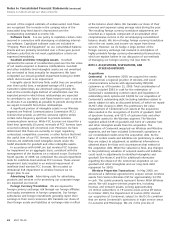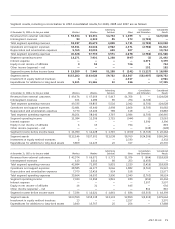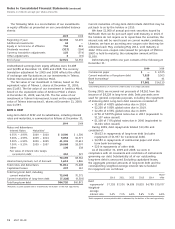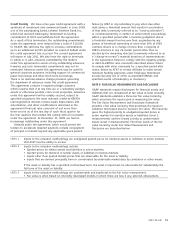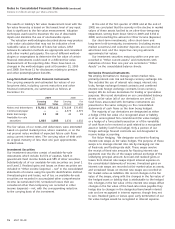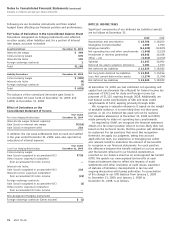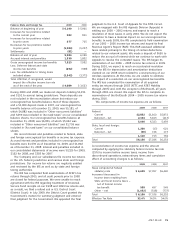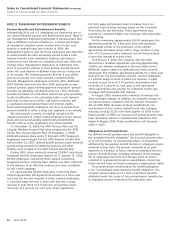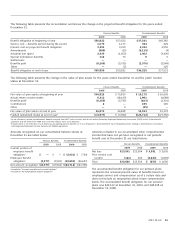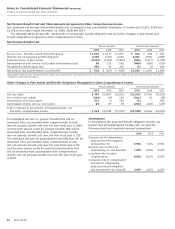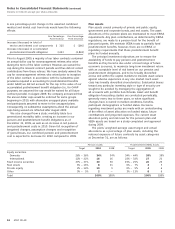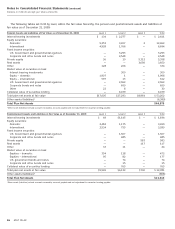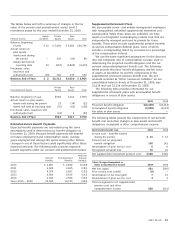AT&T Wireless 2009 Annual Report Download - page 79
Download and view the complete annual report
Please find page 79 of the 2009 AT&T Wireless annual report below. You can navigate through the pages in the report by either clicking on the pages listed below, or by using the keyword search tool below to find specific information within the annual report.
AT&T 09 AR 77
a fixed rate. Some of these instruments are designated as
cash flow hedges while others remain non-designated, largely
based on size and duration. Gains and losses at the time we
settle or take delivery on our designated foreign exchange
contracts are amortized into income over the next few months
as the hedged funds are spent by our foreign subsidiaries,
except where a material amount is deemed to be ineffective,
which would be immediately reclassified to income. In the
year ended December 31, 2009, no material ineffectiveness
was measured.
Non-designated and Discontinued Hedging Instruments
Changes in the fair value of non-designated derivatives are
recorded in other income (expense) – net, along with the
change in fair value of the underlying asset or liability, as
applicable. When hedge accounting is discontinued, the
derivative is adjusted for changes in fair value through other
income (expense) – net. For fair value hedges, the swap asset
or liability and the underlying hedged liability or asset will no
longer be adjusted for changes in fair value, and the net
adjustment to the hedged item at that time will be amortized
into earnings over the remaining life of the hedged item.
For cash flow hedges, gains and losses that were in
accumulated OCI as a component of stockholders’ equity in
connection with hedged assets or liabilities or forecasted
transactions will be recognized in other income (expense) –
net, in the same period the hedged item affects earnings.
Collateral and Credit-Risk Contingency We have entered
into agreements with most of our derivative counterparties,
establishing collateral thresholds based on respective credit
ratings and netting agreements. At December 31, 2009,
we held $222 of counterparty collateral (a receipt liability).
Under the agreements, if our credit rating had been
downgraded one rating level, we still would not have been
required to post collateral (a deposit asset). We do not
offset the fair value of collateral, whether the right to
reclaim cash collateral (a receivable) or the obligation
to return cash collateral (a payable), against the fair value
of the derivative instruments.
Following is the notional amount of our outstanding
derivative positions:
December 31, 2009
Interest rate swaps $ 9,000
Cross-currency swaps 7,502
Interest rate locks 3,600
Foreign exchange contracts 293
Total $20,395
Cash Flow Hedging Unrealized gains on derivatives
designated as cash flow hedges are recorded at fair value as
assets, and unrealized losses on derivatives designated as
cash flow hedges are recorded at fair value as liabilities, both
for the period they are outstanding. For derivative instruments
designated as cash flow hedges, the effective portion is
reported as a component of accumulated OCI until reclassified
into interest expense in the same period the hedged
transaction affects earnings. The gain or loss on the
ineffective portion is recognized in income from continuing
operations in each current period.
We designate our cross-currency swaps as cash flow
hedges. We have entered into multiple cross-currency
swaps to hedge our exposure to variability in expected
future cash flows that are attributable to foreign currency
risk generated from the issuance of our Euro- and British
pound sterling-denominated debt. These agreements include
initial and final exchanges of principal from fixed foreign
denominations to fixed U.S.-denominated amounts, to be
exchanged at a specified rate, which was determined by
the market spot rate upon issuance. They also include an
interest rate swap of a fixed foreign-denominated rate
to a fixed U.S.-denominated interest rate. We evaluate
the effectiveness of our cross-currency swaps each quarter.
In the year ended December 31, 2009, no material
ineffectiveness was measured.
Periodically, we enter into and designate interest rate locks
to partially hedge the risk of changes in interest payments
attributable to increases in the benchmark interest rate during
the period leading up to the probable issuance of fixed-rate
debt. We designate our interest rate locks as cash flow
hedges. Gains and losses when we settle our interest rate
locks are amortized into income over the life of the related
debt, except where a material amount is deemed to be
ineffective, which would be immediately reclassified to
income. In the year ended December 31, 2009, no material
ineffectiveness was measured. Over the next 12 months,
we expect to reclassify $21 from accumulated OCI to interest
expense due to the amortization of net losses on historical
interest rate locks. Our unutilized interest rate locks carry
mandatory early terminations, the latest occurring in
April 2012.
We hedge a large portion of the exchange risk involved in
anticipation of highly probable foreign currency-denominated
transactions. In anticipation of these transactions, we often
enter into foreign exchange contracts to provide currency at



